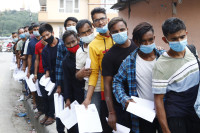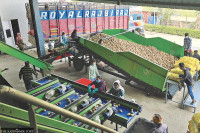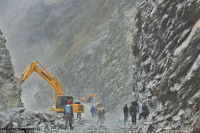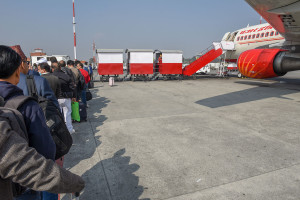Money
Nepal’s commercial flower output worth Rs671m
Nepal produces flowers worth Rs671.44 million through commercial farming annually, with seasonal flowers like marigold and dahlia accounting for almost 33 percent of the total value of the output.
Nepal produces flowers worth Rs671.44 million through commercial farming annually, with seasonal flowers like marigold and dahlia accounting for almost 33 percent of the total value of the output.
As per the findings of the first national level survey carried out by the Central Bureau of Statistics (CBS) in collaboration with the Floriculture Association Nepal in 2014-15, seven types of flowers are grown in the country.
The sector provides employment to 2,300 people on a permanent basis and to 72,400 people on daily-wage basis.
This is the first time the government’s apex statistical authority has carried out a national level census in the floriculture sector.
The country produces seasonal flowers like marigold and dahlia, among others, worth Rs221.74 million annually, the CBS said.
Perennial flowers make up the second largest production. The country grows perennial flowers like rose, chrysanthemum, carnation and azalea worth Rs167.09 million annually. The third on the list of most widely produced flowers is decorative flowers. Nepal produces decorative flowers such as dhupi (Himalayan Cypress), shrubs used in hedge and erica, among others, worth Rs120.37 million.
Similarly, cut flowers, loose flowers, garden dubo (commonly called Bermuda grass) and flowers produced through seeds, rhizome and bulb are also among the most widely produced flowers in Nepal.
Unveiling the report on Monday, Nebin Lal Shrestha, deputy director general of the CBS, said Nepal had immense potential in producing these flowers due to the diverse climatic conditions and geographical structures. “The country can benefit from expanding commercial farming of these flowers through import substitution,” he said.
According to the CBS, it has considered growing flowers on at least 8 annas of land in the hilly and mountainous regions as commercial
farming. In the Tarai, the CBS has set the threshold for commercial farming at 10 dhurs of land.
The CBS said it conducted the study in two phases—identifying the districts producing flowers in the first stage and then doing a detailed survey of these districts in the second phase. Farmers in 561 locations of 36 districts have been found producing flowers for commercial purposes. Of them, 381 are located in the Kathmandu Valley and adjoining districts. The top five districts in flower production are Kathmandu (50.4 percent of the total output), Lalitpur (7.1 percent), Morang (4.1 percent), Kaski (3.9 percent) and Bhaktapur (3.6 percent).
Around 48 percent of the flower producing nurseries have not obtained a licence. Among the proprietors of these nurseries, 71 percent are men and the rest are women. Tamang, Chhetri and Newar are the major communities involved in flower production.
Lack of subsidised loans, training, irrigation facilities and improved seeds and wild price fluctuations are the major problems that flower producers have been facing.




 19.12°C Kathmandu
19.12°C Kathmandu













